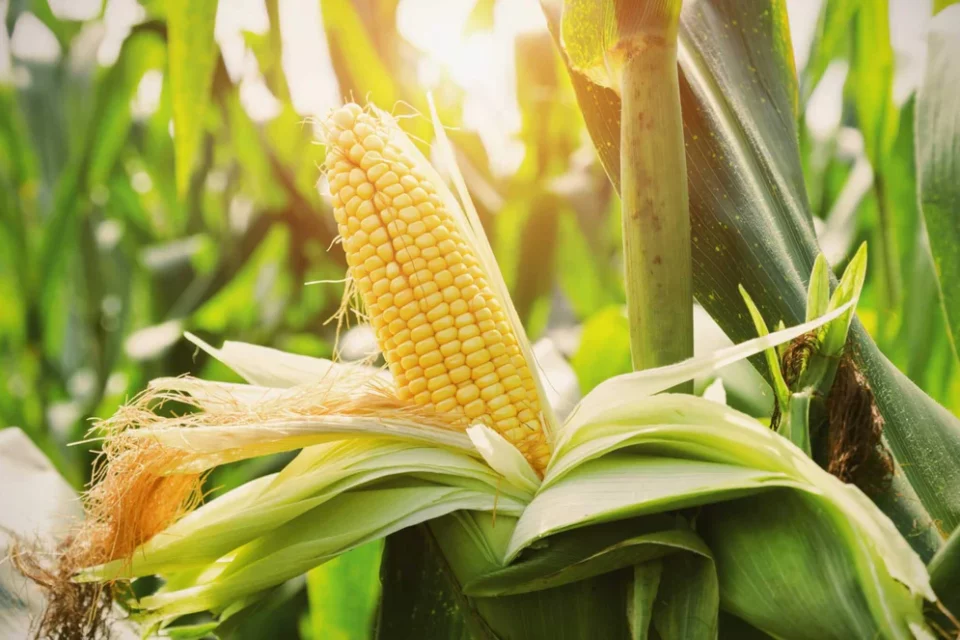How to Grow Corn Seeds

Sinking your teeth into a perfectly ripened ear of sweet corn is one of the finest pleasures of summer. Learn expert techniques for growing corn.
Corn needs plenty of space for two reasons — it takes up a lot of nutrition from the soil, and it is primarily pollinated by wind. As grains of pollen are shed by the tassels that grow from the plants’ tops, they must find their way to the delicate strands of silk that emerge from newly formed ears. To make sure silks are nicely showered with pollen, grow corn in blocks of short rows rather than in a long, single row. In a small garden, 15 plants set 1 foot apart can be grown in a 3 x 5-foot bed. Growing corn on this tiny scale is a good way to introduce yourself to the crop if you’ve never grown it. After the first year you will probably want to increase the size of the planting to at least 4 rows 10 feet long.
Corn plants are not like tomatoes or most other vegetables, which bear over a long period of time. Instead, they form a few ears per stalk and they are finished. Because of this, gardeners who have the space often make 2 or 3 plantings 2 weeks apart to keep the harvest coming.
Quick Guide to Growing Corn
- Hold off on planting corn in spring until after the last frost.
- Space seedlings 8 to 12 inches apart in an area with full sun and fertile, well-drained soil with a pH of 6.0 to 6.8.
- Improve native soil conditions by mixing in several inches of aged compost or other rich organic matter.
- Corn will grow quickly when it is watered well. Check soil moisture often and consider using a soaker hose if you have a small plot.
- Corn has a big appetite, so it’s important to feed plants with a water-soluble plant food regularly.
- Add a 3-inch layer of mulch to keep soil moist and prevent weeds.
- Harvest corn when the ear feels plump and the silks are brown and dry.
Soil, Planting, and Care
Corn needs a spot with that gets full sun and has fertile, well-drained soil with a pH of 6.0 to 6.8. It’s a good idea to improve the soil to improve nutrition and texture by mixing aged compost-enriched Miracle-Gro® Performance Organics® All Purpose In-Ground Soil in with the top few inches of native soil. Seedlings can be set out as soon as the last spring frost has passed. Space plants 8 to 12 inches apart. In case of a surprise late frost, be prepared to cover seedlings with a fabric row cover. In cold climates you can plant in a raised bed covered with black or IRT plastic (infrared transmitting plastic) that will warm the soil. If possible, lay the plastic a week or so before planting.
Plan to fertilize regularly because corn is a hungry plant. In addition to setting out young plants in the kind of nutrient-rich soil mentioned above, you’ll want to feed corn regularly with a continuous-release fertilizer like Miracle-Gro® Performance Organics® Edibles Plant Nutrition Granules that nourishes both the soil and your plants. (Be sure to follow rates given on the label of any fertilizer you are using.) Water your corn once or twice weekly, more if the weather is hot and dry.
Normal plants should grow fast with dark green healthy leaves. Corn will tell you if it is hungry by turning very light green. If so, feed again.
Corn grows fast and needs lots of water to grow properly. It also has shallow roots that make it susceptible to drought. Soaker hoses will insure that your corn gets the water it needs. However, for a large planting, soaker hoses may not be practical.
Hopi and Navaho Techniques
Native Americans in arid climates planted corn in basins to catch spring rainwater and help keep the corn roots down where water would be available longer. The basin was about 4 inches deep and 2 to 3 feet wide with a raised ridge made from the excavated soil around it. Plants were arranged so that they formed a spiral from the center to help with support in wind and with pollination. If you live in an arid climate or a hot climate and have poor sandy soil, as in the Coastal Plains, this technique could help ensure a good harvest.
Troubleshooting
Corn plants that are blown over by gusty storms usually right themselves after a few days of sunny weather. As you shuck and clean your corn, pop off ear tips damaged by corn earworms. The different types of corn should not be allowed to cross-pollinate, so plant them in such a way that pollen from one type does not reach another type. If you or a nearby neighbor grow multiple types, be sure that they are isolated by at least 250 feet or that their timing is such that they are not in bloom at the same time. If not, the pollen from types that are not the same can muddy their characteristics to the point of ruining sweetness and flavor.
Raccoons love corn. The most effective way to keep them out of the patch is to surround it with a fence with 2 strands of electric wire 4 and 12 inches from the ground. Some gardeners have been successful with throwing blackbird netting over and around the plants because some raccoons don’t like it. The methods for keeping raccoons out of corn are as varied as gardeners themselves. We’ve heard of people putting flashing lights in the corn patch, putting a radio on a timer to blare loud music, laying newspaper in rows because the raccoons don’t like to walk on the crinkly paper, spraying animal repellents, and other techniques, but a physical barrier such as an electrified fence seems to be the most reliable.